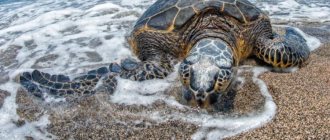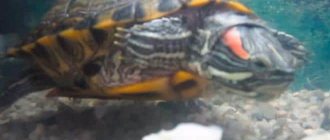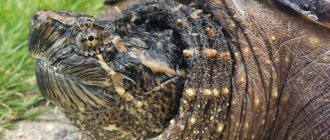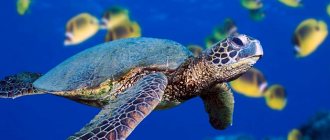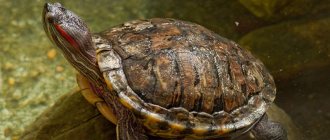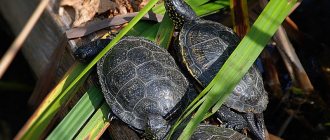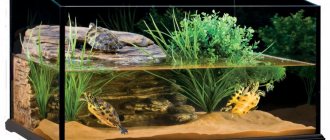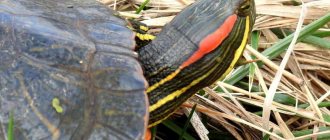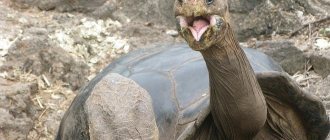Let's feed our pets according to the rules! A competent diet is important not only for a person who has it easier - he can, after reading all kinds of useful literature, develop it for himself. It is much worse for animals (including turtles): they are entirely dependent on the owner’s knowledge about the proper nutrition of their pets.
Therefore, pet owners should be “savvy on all fours” in this regard. After all, feeding reptiles with food that is not suitable for a particular species will result in troubles with the digestive and other internal organs, and disturbances in metabolic processes in the turtle’s body.
Physiological characteristics of turtles
All turtles are divided into 2 types:
- waterfowl;
- land.
Both varieties can be kept at home and their nutrition will differ. Thus, waterfowl are often predators, while land animals are vegetarians. Omnivores include marsh and semi-aquatic reptiles. But everyone’s food should be as diverse as possible, so the pet will receive the entire range of nutrients, vitamins and microelements.
Monotonous food will lead to deterioration in your pet's health.
Both types of turtles (land and waterfowl) lack teeth. They grind their food with rhamphothecae. These are special horny sheaths located on the upper and lower jaws. Other individuals help themselves with their paws while eating.
Artificial feed
Pet stores provide pet owners with a huge selection of food for land and aquatic turtles. It is sold in capsules, granules, tablets and flakes. The large amount of food produced by manufacturers does not always meet the needs of a particular species. Often, turtle food is modified fish food. Some animals are irritated by the pungent smell, and they demonstratively turn away from it. There are foods in which the content of calcium, protein and vitamins does not meet the needs of turtles. But some animals are happy to eat only food. Of the manufacturing companies, JBL, Sera, Nutra Fin, Tetra have proven themselves well.
Homemade food for red-eared turtles
If store-bought artificial food is not suitable, you can prepare your own treats for turtles.
Feed composition:
- cabbage – 50 gr.;
- carrots – 70 gr.;
- non-fatty fish – 145 g;
- apples – 50 gr.;
- squid meat – 100 gr.
Cooking method. All ingredients should be passed through a meat grinder, add 2 eggs, gelatin diluted in hot water (per 150 ml - 30 g) and milk in a volume of 150 g. Mix thoroughly, let cool and add 20 drops of Tetravita. The shelf life of the food in the refrigerator is 1 week. Before feeding, the mixture is cut into pieces and given to the turtle.
The prepared food is enough for 10 feedings, per 1 turtle with a shell length of 15 cm. If the animal is sick, you can add medicine to the food. Gelatin can be replaced with agar-agar. This will prevent the cubes from quickly melting in the water.
Feeding turtles food for cats and dogs. "Pros and cons"
Red Ears really like combined foods, but they are intended for feeding warm-blooded animals and are not suitable for turtles. The food contains a completely different set of substances that are useful for cats and dogs, but completely useless for turtles.
Nutrition of domestic turtles depending on the species
Currently, more than 300 species of turtles are known. But there are several that are most widespread, including the following.
Pond slider
This turtle is one of the most popular. Its name refers to the presence of a red spot on the head in the area of the ears just below the eyes. This is an aquatic species that requires keeping in an aquarium or aquaterrarium. It is worth organizing an island of land for the red-eared reptile to climb onto, for example, an artificial rock.
In food, this species prefers small fish with bones, fish fry, shrimp, chicken breast, insect larvae, gammarus, hard-boiled egg yolk, etc. But he will not refuse plant foods. For example, from a slice of cucumber, apple or lettuce. Moreover, young individuals prefer animal food, while older individuals prefer plant food.
With proper care and nutrition, turtles will feel good and will delight their owners for many years. If the turtle does not eat and is lethargic, the rules for keeping it are most likely violated; read about what to do in this case here.
Central Asian tortoise
This is a land species of turtle, characterized by extreme slowness. The color of the shell is yellow-beige with black and brown splashes. The Central Asian tortoise is listed in the Red Book, but at the same time it is very popular among reptile breeders. They are kept in a terrarium with a volume of at least 100 liters; special soil is poured onto the bottom - a mixture of sand and small pebbles. They love to burrow into the sand and dig holes in it.
They eat exclusively plant foods; feeding them meat is strictly prohibited. It is extremely rare to treat them with several insect larvae.
Trionix Chinese
This species of turtle is gaining increasing popularity among amphibian lovers. Its main feature is its soft green shell. The horn plates are completely absent, it is simply covered with leather.
This turtle has a very aggressive character, often bites the owner and, despite the lack of teeth, causes pain due to the presence of developed muscles on the jaws.
They belong to waterfowl and are listed in the Red Book.
When keeping it at home, it is important to organize conditions for the turtle that are close to natural: a sufficiently large amount of soil is poured onto the bottom of the aquarium, since Trionix likes to bury itself in the sand. He also needs a rock to bask on land.
In her diet she prefers food of animal origin: low-fat fish with small bones (hake, pollock, cod, gobies), chicken and beef liver, heart. They give fish fry and small frogs in minimal quantities. A little greenery or a piece of tomato won't hurt either.
European marsh turtle
These are waterfowl turtles. Their main feature is a black shell and body with sparse dots and thin stripes of yellow. When kept in an aquaterrarium, be sure to organize an elevation on which the pet can climb.
These turtles are omnivores. Their diet should include low-fat meat (such as chicken) and plant foods. In order to obtain calcium, they are given fish with small bones. Large ones are ground and also added to food.
Musk turtle
In nature, it lives in bodies of fresh water: rivers and lakes in the southeastern United States and Canada. Its peculiarity lies in the presence of special glands under the shell, from which, at the moment of danger, a special liquid is released that has a sharp musky odor. This is how the turtle got its name.
It has a dull dirty brown color. In food it prefers fish, aquatic insects, shrimp, and carrion. Enjoys eating seaweed. Therefore, when keeping a house in an aquarium, you need soil with aquatic plants planted in it.
What do wild turtles eat?
Based on the type of food, these reptiles are divided into the following three groups:
- herbivores,
- predatory,
- omnivores.
Each of the groups, naturally, has its own taste preferences, and their “rationing” must be arranged in the ratio of plant and animal components of the diet determined by nature.
Herbivores are land turtles, on the “table” of which animal food can account for only 5% of the total mass. Everything else is purely plant-based. The usual food for them is herbaceous annual plants called desert ephemerals, sprouts of perennial grasses and shrubs. Turtles eat not only fresh greens, but also dry grass, flowers, as well as seeds and fruits.
For predators - aquatic and swamp turtles - the opposite is true: if animal products on the menu should be present in an amount of 70-90%, then the remaining 10-30 percent is represented by “herbs”. In the natural environment, they eat small frogs, insect larvae, mollusks, woodlice, fish, and worms. And coastal and aquatic plants act as green food.
The diet of omnivorous amphibians consists of equal parts of all types of food - 50 to 50.
How to feed aquatic turtles
This species is a predator in its natural habitat, and this should be taken into account when maintaining a home. The main types of food that pets are given are listed below.
Fish
For young turtles it is cut into small pieces along with the bones; adults are given larger pieces. If there are large bones, they are chopped or ground. Fish can be fresh or defrosted. They produce low-fat species: perch, cod, hake, pollock. Occasionally, fish with a high fat content is allowed, for example, capelin, sprat. They feed it in minimal quantities and keep it in warm water beforehand.
Before feeding, the fish is not gutted, but given along with its entrails. A special delicacy for turtles is caviar.
Seafood
The diet of these turtles must include shrimp, scallops, small octopuses, squid, mussels, and crayfish tails. You can give baby frogs after checking with your veterinarian which type is suitable for a particular turtle.
Meat
Low-fat varieties of meat are always added to turtle food. For example, boiled chicken, beef or chicken liver.
It is unacceptable to feed your pet fatty meat products (pork, lamb), as well as prepared foods (sausages, sausage, etc.).
Plant food
It is also a necessary component in the diet of aquatic turtles. However, they give it periodically. If this is not done, the pet will begin to eat ornamental plants from the aquaterrarium.
List of allowed vegetables and fruits:
- cabbage;
- carrot;
- cucumbers;
- zucchini;
- beet;
- dandelion and lettuce leaves;
- tomatoes;
- apples;
- pears;
- pumpkin pulp.
It is allowed to give aquatic turtles dry factory food in the form of granules and sticks, and in the cold season - vitamin supplements.
Nutrition of land turtle species
Feeding this species is a little more difficult than their aquatic counterparts, as they are herbivores. But it is important to ensure that they receive the full range of nutrients from their food.
Approximate ratio of foods in the diet of a land turtle:
- Plant foods make up about 80% of the diet: green parts of dandelion, plantain, alfalfa, sorrel, legumes (peas, beans), lettuce. Parsley and dill are added, but not all individuals eat them. The latter are placed in the feeder, and the pet decides how much to eat. The uneaten remains are then thrown away to prevent them from rotting.
- 15% - vegetables such as cucumbers, tomatoes, pumpkin and zucchini pulp, carrots, sweet peppers, etc.
- 5% - some varieties of fruit. For example, pear, apple, nectarine, apricot, seedless watermelon pulp.
As a dessert, you can occasionally give a little strawberry, banana, pineapple, peeled grapefruit or orange, and corn seeds.
All vegetables and fruits are allowed only in raw form. Heat treatment is excluded; feeding such food will worsen the turtle’s condition.
Land species of turtles get the bulk of their water from food, but they still need to be given a drink periodically. Moreover, everything is individual: some individuals drink every 7 days, and some drink once a month. It is worth observing your pet and developing an individual water supply schedule.
Would you like a drink, turtle?
Let your landlubber friend splash in the water sometimes.
Turtles of land species, as a rule, can obtain a sufficient amount of moisture from green and fruit and vegetable food. It is also known that these animals have the ability to absorb water through their skin. It is enough to satisfy the turtle's need for water during its 10-minute stay in the bathing suit.
You can ensure your pet is hydrated by bathing it daily. To do this, water is poured into the bath so that it covers only half of the turtle’s body. The head should remain above the water.
As for aquatic species, this is all a matter of course for them.
Like any living organism, turtles - whether a land herbivore or a freshwater carnivore - need a complete and balanced diet. A person who wants to have this reptile as a pet must approach this issue very responsibly.
Many people think that a turtle is an unpretentious animal; give it a cabbage leaf, and that’s enough. To avoid dramatic mistakes, you need to thoroughly familiarize yourself with the rules and diet of this reptile.
Rules for feeding pet turtles
Pets are fed at approximately the same time, so they get used to it and expect food. It is important to provide enough food, but not to overfeed. Young individuals (up to 2 years old) eat daily, and older ones - once every 2 days.
At the same time, you cannot give food from your hands; it must be placed in the feeder for land reptiles and in the water for amphibious reptiles. Otherwise, pets will get used to it and will not eat from the bowl.
Remains of food are removed from the terrarium or aquarium. Otherwise, they may spoil, and eating them will lead to poisoning of the turtles.
In autumn and winter, the amount of food is slightly reduced, since the activity of reptiles decreases, but vitamin complexes and supplements are added. The veterinarian will tell you which ones are best to give and their quantity.
Products prohibited for turtles
There are many foods that are strictly prohibited for turtles. These include:
- plants (poisonous) belonging to the nightshade family, ranunculaceae, as well as medicinal plants containing alkaloids;
- peel of all citrus fruits;
- seeds of berries and fruits;
- radishes and radishes;
- dry and wet factory food for other pets;
- bread, dairy products;
- all food that has undergone heat treatment (with the exception of boiled egg yolk and chicken breast);
- indoor and ornamental plants: dieffenbachia, rhododendron, violet, jasmine, crocuses, daffodils, etc.
Common mistakes when feeding turtles
There are several most common mistakes that novice owners make:
- Feeding from the common table with leftover food.
- Excessive addition of factory-produced vitamin supplements to the diet. They are given no more than once every 7 days.
- Self-treatment of a pet without consulting a veterinarian.
- An unbalanced diet is an excessive passion for fish products, which leads to an excess of vitamin B in the turtle’s body.
Symptoms indicating improper feeding:
- refusal to eat;
- slower growth in young turtles;
- decreased motor activity, lethargy;
- impaired coordination of movements.
With proper feeding and care, the turtle will delight its owners with good health and a long life expectancy.
Mineral and vitamin supplements
A young reptile needs calcium during the period of active growth, formation of the skeleton and shell. Every day there should be a pinch of bone meal in the diet; it is added to the main feed. Adults should be given 1 teaspoon of bone meal once a week. This supplement is sold at a pet store or at a market that sells grain for poultry.
As a substitute, you can use eggshells ground in a coffee grinder.
Pet stores offer a large selection of vitamin supplements for red-eared turtles. They must be given in strict accordance with the recommendations on the packaging.
An expired vitamin supplement can become poisonous to a turtle; you need to pay attention to this when purchasing and storing vitamins.
Bone flour

